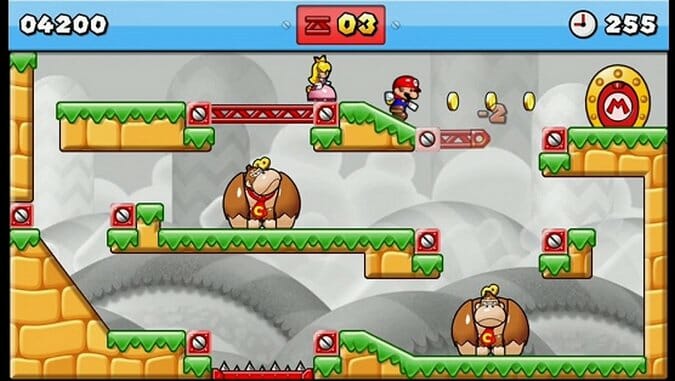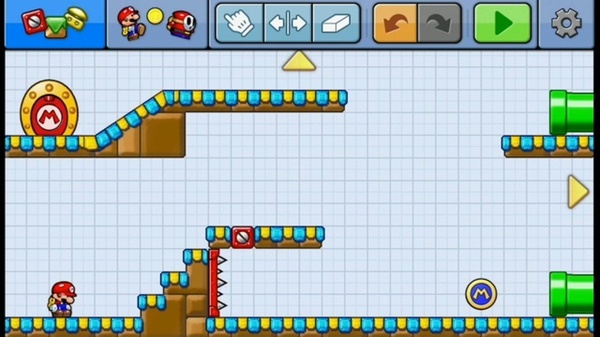
Unlike so many games they star in, Mario vs Donkey Kong: Tipping Stars starts off quickly. No extended cutscene to explain the ever-more-elaborate reason why a woman has been kidnapped (here it’s Pauline, the proto-Princess the giant ape’s been kidnapping since the original Donkey Kong, Mario’s debut). Just a single, still image. And you’re off.
I understand this is the latest game in the Mario vs Donkey Kong series, but I have no idea what the, well, the “lore” for this particular franchise is. I’m not complaining: showing an ape carry off a woman in a dress and then immediately jumping into a game where wind-up versions of Mario characters walk mindlessly while you guide them toward exits probably gains very little from an explanation.
It’s structured in a Mario style: eight worlds subdivided into eight stages. Each stage is timed: you earn a trophy (bronze, silver, or gold) upon completion, depending on your score. That’s determined by the time remaining on the clock when you finish (just like in the original Super Mario Brothers) and how many coins you’ve collected in the stage. There’s not much of a trade-off between the two: collecting all the coins almost always nets you a silver, with the time remaining kicking you up into the gold. Opt to skip coins in favor of a faster run on the stage and you’ll usually just end up with a bronze.
Each world adds its own new interactive object. A single scene before the world starts shows you how it works (usually tapping and dragging): springs that send the toy-characters flying, conveyor belts, lifts.
Once a character is set in motion (either by a stylus-tap or being bumped into by another walking character), they continue straight ahead until they hit a wall or other form of resistance, then they turn and walk in the other direction.
Stages either have multiple exits (each coded to a specific character), or one exit that all characters must pass through. In the case of the latter, only a few seconds are allowed to pass between each character’s entrance. Wait too long and you fail the stage.
This time limit means single-exit stages (which predominate) require a choreography of characters in time as well as space: your best bet is usually to keep all of them as close together as possible so that once the first one reaches the door, the others are right behind. Of course, in the more complex stages (later in the game, but especially the bonus stages unlocked by getting gold trophies in the main game) this is more difficult to do, and it often requires sacrificing large amounts of time while you let one or two loop through an area while the others catch up.
Final stages in each world begin with one of the toys being possessed by a…well, I’m not really sure what it is. It starts that toy in motion and, if any of the other toys run into it, the stage is over (the same happens with other hazards: spikes, fireballs, Thwomps). The toy has to be saved to successfully complete the level, so you have to maneuver one of the other characters into it after they’ve picked up a hammer power-up.
The hammer causes the character to continue marching along their path while rapidly swinging it for a brief period of time. Some stages require you to break through walls, knock out hazards, or destroy enemies with it. Hitting the possessed toy will free it and allow you to guide it to the exit as well.
It’s a puzzle game, not a platformer, and while they’re not as predominantly needed as in the latter, quick thinking and manual dexterity are important. You do have as much time as you want when a level starts to get an idea of the lay of the land. You can clear the bars and conveyors and springs that you place using the stylus (in specifically marked spots), storing them for when you need them in your solution. The clock doesn’t start until you put your first character in motion.
There are specific solutions to each puzzle, varied a bit by the order in which you activate characters and whether or not you’re quick enough to manipulate the environment to avoid mistakes. The game also features a workshop mode which allows you to design stages and share them online. You use stars to buy different things in the workshop, allowing you to make more complex puzzles. You can also use the stars to tip other level designers. Tipping them stars (get the title now?) lets you collect stamps.
There are a lot of, well, metrics in this game that transform into other metrics. Coins and time turn into points which turn into trophies and stars which turn into extra levels and extra things to build levels and stamps.
When I logged into the Community section, where user-created stages are hosted, the Most Popular level at the time was called “Free Stars”. Two Mario toys sat in front of a line of coins that led directly to a door. They started their walking and a few seconds later I had received a gold trophy and, as the designer promised, stars. I had to: the workshop won’t let you share a stage without first completing it, and the iconography is so clear and obvious that once you’ve learned what is possible in the game it’s difficult for it to become deceptive.
Not to say that the later stages in the game aren’t complicated; they are. It’s just that by designing things to be so clear, by limiting where things can be placed, it’s a game more of putting things in the obvious place at the right time. Removing “what”, limiting “where,” and focusing on “when” limits what can really be done in the main stages. The minimal “storytelling” that wraps the main game suggests where the developers wanted the focus to be: in the experimentation and design of the Workshop and in the sharing of the Community. That other stuff? Just a tech demo.
Mario vs. Donkey Kong: Tipping Stars was developed and published by Nintendo. It is available for the 3DS and Wii U.
Brian Taylor was really into The Incredible Machine.
